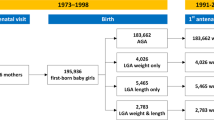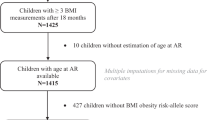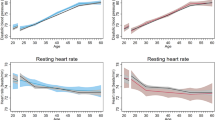Abstract
OBJECTIVES:
Rates of high birth weight infants, overweight and obese children and adults are increasing. The associations between birth weight and adult weight may have consequences for the obesity epidemic across generations. We examined the association between mothers’ birth weight for gestational age and adult body mass index (BMI) and these factors’ joint effect on risk of having a large-for-gestational-age (LGA) offspring (>+2 s.d. above the mean).
DESIGN:
A cohort of 162 676 mothers and their first-born offspring with birth information recorded on mothers and offspring in the nation-wide Swedish Medical Birth Register 1973–2006.
RESULTS:
Compared with mothers with appropriate birth weight for gestational age (AGA; −1 to +1 s.d.), mothers born LGA had increased risks of overweight (BMI 25.0–29.9; odds ratio (OR), 1.50; 95% CI 1.39–1.61), obesity class I (BMI 30.0–34.9; OR 1.77; 95% CI 1.59–1.98), obesity class II (BMI 35.0–39.9; OR 2.77; 95% CI 2.37–3.24) and obesity class III (BMI ⩾40.0; OR 2.04; 95% CI 1.49–2.80). In each stratum of mother's birth weight for gestational age, risk of having an LGA offspring increased with mother's BMI. The risk of an LGA offspring was highest among women with a high (⩾30) BMI who also had a high birth weight for gestational age (>+1 s.d.). In these groups, the ORs for LGA offspring ranged from 5 to 14 when compared with mothers born AGA with normal BMI (⩽24.9). However, the strongest increase in risk by BMI was seen among mothers born SGA: the OR of having an LGA offspring was 13 times as high among SGA mothers with BMI ⩾35.0 compared with the OR among SGA mothers with normal BMI (ORs=4.61 and 0.35, respectively).
CONCLUSIONS:
Prenatal conditions are important for the obesity epidemic. Prevention of LGA births may contribute to curtail the intergenerational vicious cycle of obesity.
This is a preview of subscription content, access via your institution
Access options
Subscribe to this journal
Receive 12 print issues and online access
$259.00 per year
only $21.58 per issue
Buy this article
- Purchase on Springer Link
- Instant access to full article PDF
Prices may be subject to local taxes which are calculated during checkout

Similar content being viewed by others
References
National Task Force. Overweight, obesity, and health risk. National task force on the prevention and treatment of obesity. Arch Intern Med 2000; 160: 898–904.
Berrington de Gonzalez A, Hartge P, Cerhan JR, Flint AJ, Hannan L, MacInnis RJ et al. Body-mass index and mortality among 1.46 million white adults. N Engl J Med 2010; 363: 2211–2219.
Fontaine KR, Redden DT, Wang C, Westfall AO, Allison DB . Years of life lost due to obesity. JAMA 2003; 289: 187–193.
Freedman DS, Khan LK, Serdula MK, Galuska DA, Dietz WH . Trends and correlates of class 3 obesity in the United States from 1990 through 2000. JAMA 2002; 288: 1758–1761.
Jungheim ES, Moley KH . Current knowledge of obesity's effects in the pre- and periconceptional periods and avenues for future research. Am J Obstet Gynecol 2010; 203: 525–530.
Ananth CV, Wen SW . Trends in fetal growth among singleton gestations in the United States and Canada, 1985 through 1998. Semin Perinatol 2002; 26: 260–267.
Bergmann RL, Richter R, Bergmann KE, Plagemann A, Brauer M, Dudenhausen JW . Secular trends in neonatal macrosomia in Berlin: influences of potential determinants. Paediatr Perinat Epidemiol 2003; 17: 244–249.
Surkan PJ, Hsieh CC, Johansson AL, Dickman PW, Cnattingius S . Reasons for increasing trends in large for gestational age births. Obstet Gynecol 2004; 104: 720–726.
Hadfield RM, Lain SJ, Simpson JM, Ford JB, Raynes-Greenow CH, Morris JM et al. Are babies getting bigger? An analysis of birthweight trends in New South Wales, 1990–2005. Med J Aust 2009; 190: 312–315.
Bao C, Zhou Y, Jiang L, Sun C, Wang F, Xia W et al. Reasons for the increasing incidence of macrosomia in Harbin, China. BJOG 2011; 118: 93–98.
Ahlsson F, Gustafsson J, Tuvemo T, Lundgren M . Females born large for gestational age have a doubled risk of giving birth to large for gestational age infants. Acta Paediatr 2007; 96: 358–362.
Ludvigsson JF, Otterblad-Olausson P, Pettersson BU, Ekbom A . The Swedish personal identity number: possibilities and pitfalls in healthcare and medical research. Eur J Epidemiol 2009; 24: 659–667.
National Board of Health and Welfare. The Swedish Medical Birth Register: a summary of content and quality; February 24, 2011. Available from: http://www.socialstyrelsen.se/Lists/Artikelkatalog/Attachments/10655/2003-112-3_20031123.pdf.
Hogberg U, Larsson N . Early dating by ultrasound and perinatal outcome. A cohort study. Acta Obstet Gynecol Scand 1997; 76: 907–912.
Niklasson A, Ericson A, Fryer JG, Karlberg J, Lawrence C, Karlberg P . An update of the Swedish reference standards for weight, length and head circumference at birth for given gestational age (1977–1981). Acta Paediatr Scand 1991; 80: 756–762.
Marsal K, Persson PH, Larsen T, Lilja H, Selbing A, Sultan B . Intrauterine growth curves based on ultrasonically estimated foetal weights. Acta Paediatr 1996; 85: 843–848.
Druet C, Ong KK . Early childhood predictors of adult body composition. Best Pract Res Clin Endocrinol Metab 2008; 22: 489–502.
Lunde A, Melve KK, Gjessing HK, Skjaerven R, Irgens LM . Genetic and environmental influences on birth weight, birth length, head circumference, and gestational age by use of population-based parent-offspring data. Am J Epidemiol 2007; 165: 734–741.
Blakemore AI, Froguel P . Investigation of Mendelian forms of obesity holds out the prospect of personalized medicine. Ann NY Acad Sci 2010; 1214: 180–189.
Villamor E, Cnattingius S . Interpregnancy weight change and risk of adverse pregnancy outcomes: a population-based study. Lancet 2006; 368: 1164–1170.
Ludwig DS, Currie J . The association between pregnancy weight gain and birthweight: a within-family comparison. Lancet 2010; 376: 984–990.
Hedderson MM, Gunderson EP, Ferrara A . Gestational weight gain and risk of gestational diabetes mellitus. Obstet Gynecol 2010; 115: 597–604.
Reece EA, Leguizamon G, Wiznitzer A . Gestational diabetes: the need for a common ground. Lancet 2009; 373: 1789–1797.
Whitaker RC, Dietz WH . Role of the prenatal environment in the development of obesity. J Pediatr 1998; 132: 768–776.
Leon DA, Koupilova I, Lithell HO, Berglund L, Mohsen R, Vagero D et al. Failure to realise growth potential in utero and adult obesity in relation to blood pressure in 50 year old Swedish men. BMJ 1996; 312: 401–406.
Frankel S, Elwood P, Sweetnam P, Yarnell J, Smith GD . Birthweight, body-mass index in middle age, and incident coronary heart disease. Lancet 1996; 348: 1478–1480.
Lithell HO, McKeigue PM, Berglund L, Mohsen R, Lithell UB, Leon DA . Relation of size at birth to non-insulin dependent diabetes and insulin concentrations in men aged 50–60 years. BMJ 1996; 312: 406–410.
Yogev Y, Visser GH . Obesity, gestational diabetes and pregnancy outcome. Semin Fetal Neonatal Med 2009; 14: 77–84.
Donahue SM, Kleinman KP, Gillman MW, Oken E . Trends in birth weight and gestational length among singleton term births in the United States: 1990–2005. Obstet Gynecol 2010; 115: 357–364.
Zhang X, Decker A, Platt RW, Kramer MS . How big is too big? The perinatal consequences of fetal macrosomia. Am J Obstet Gynecol 2008; 198: 517 e511–e516.
Acknowledgements
The study was supported by the European Union's Seventh Framework Programme (FP7/2007–2011) under grant agreement No. 259679.
Author information
Authors and Affiliations
Corresponding author
Ethics declarations
Competing interests
The authors declare no conflict of interest.
Rights and permissions
About this article
Cite this article
Cnattingius, S., Villamor, E., Lagerros, Y. et al. High birth weight and obesity—a vicious circle across generations. Int J Obes 36, 1320–1324 (2012). https://doi.org/10.1038/ijo.2011.248
Received:
Revised:
Accepted:
Published:
Issue Date:
DOI: https://doi.org/10.1038/ijo.2011.248
Keywords
This article is cited by
-
Fasting plasma glucose and fetal ultrasound predict the occurrence of neonatal macrosomia in gestational diabetes mellitus
BMC Pregnancy and Childbirth (2023)
-
Impact of BMI and smoking in adolescence and at the start of pregnancy on birth weight
BMC Pregnancy and Childbirth (2023)
-
Association of birth and childhood weight with risk of chronic diseases and multimorbidity in adulthood
Communications Medicine (2023)
-
Prenatal oxidative stress and rapid infant weight gain
International Journal of Obesity (2023)
-
Childhood obesity and adverse cardiometabolic risk in large for gestational age infants and potential early preventive strategies: a narrative review
Pediatric Research (2022)



